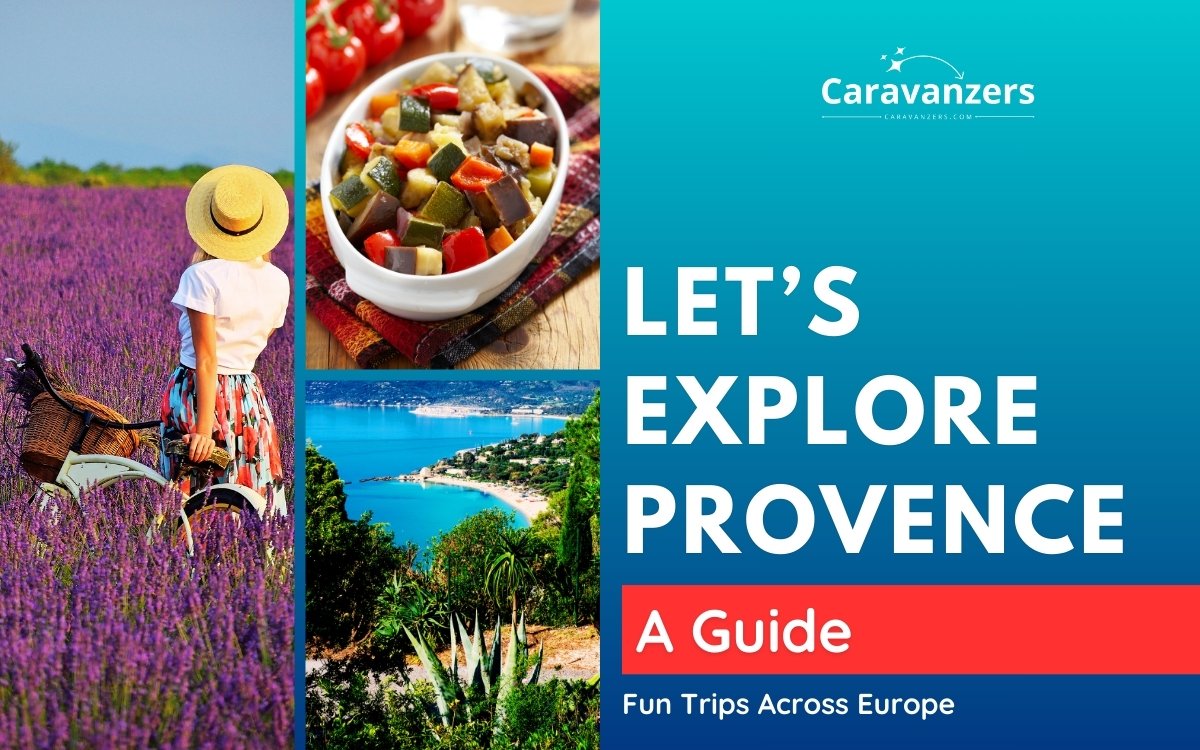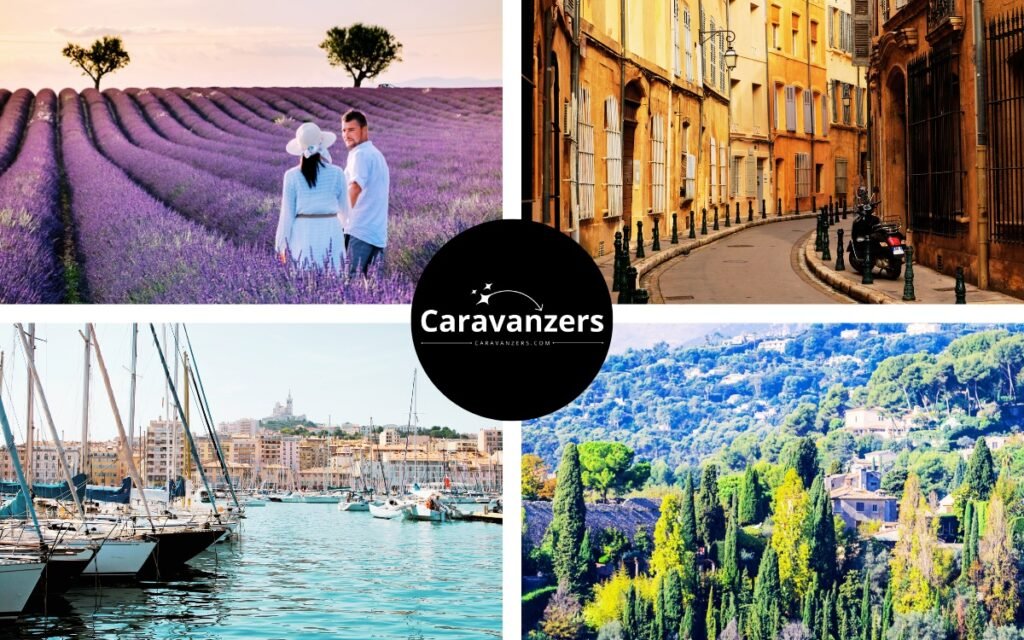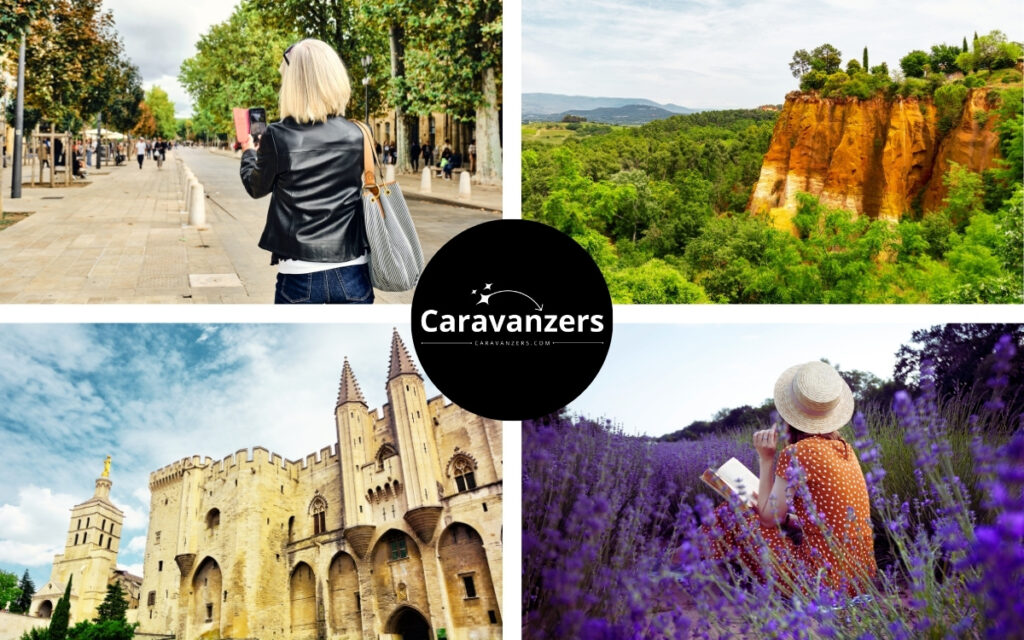
Provence travel guide. Use this guide to plan a trip to this popular region in France, including must-see sites like lavender fields.
Travelers love visiting Provence for many reasons. The region has a blend of historic cities, beautiful landscapes, and delicious food.
I would say Provence is the quintessential Mediterranean lifestyle.
So, if you plan to visit, get ready to jot down a ton of information, as I will share tips and ideas.
You will learn where to stay, what foods to try, and, most importantly, what fun things to do, and so much more.
Let’s get started.
France Travel Basic
France is part of the Schengen Area, but you’ll need a valid passport for your visits if you’re outside of this zone.
Make sure your passport has at least six months’ validity.
Americans can stay visa-free for up to 90 days, while Australians, Canadians, and Britons can do so for up to 180 days within a 12-month period.
Check for any travel advisories or entry requirements.
Meanwhile, the nearest major airport to Provence is Marseille Provence Airport (MRS).
This airport has convenient access to the region’s cities and attractions for domestic and international travelers.
Provence also has well-connected train services. Avignon’s TGV station is a major hub.
Its high-speed connections to other French cities make train travel an efficient option for this region.
Of course, the currency in France is the Euro (€), and ATMs are readily available in cities and towns for convenient currency exchange.
Finally, the best time to visit Provence is during late spring (May to June) and early fall (September to October).
In these periods, the weather is pleasant, and tourist crowds are lighter.
Welcome to Provence

Provence is nestled in southeastern France, about an 8-hour train ride from Paris. This is one of the most popular regions of the country.
The region is really beautiful, with its picturesque landscapes that blend lavender fields, vineyards, and olive groves.
Plus, its historical connections to the Romans and the Papacy make it a great place to visit for history buffs.
Of course, there are a ton of quaint villages with narrow streets, lively markets, and charming cafes that characterize the area, too.
Meanwhile, the Mediterranean coastline adds allure with its sun-soaked beaches and azure waters.
You should also know Provence has a popular cuisine with yummy dishes infused with local herbs and flavors.
Finally, artistic legacies, such as the works of Van Gogh, further make the area a popular destination for art lovers.
In other words, Provence is perfect for history, nature, and culinary enthusiasts alike.
Where to Stay in Provence
In my opinion, European regions are better to visit when you can stay in a city, or at least a larger village.
Provence has interesting cities, including Marseille. This is a bustling port city, combining an amazing maritime heritage with contemporary life.
Marseille has the iconic Vieux-Port and diverse neighborhoods, and with a population of about a million, it is definitely a big city.
Nîmes, another Roman gem, showcases the well-preserved Arena and Maison Carrée.
With a population of 150,000 and a younger crowd, I would say Nîmes is perfect for solo travelers.
Avignon is smaller, but this city is popular for its well-preserved medieval architecture, including the historic Papal Palace.
This is a great place for those who want a city life without the huge crowds since it has a population of 100,000.
Meanwhile, Aix-en-Provence is a bit larger, with a population of 145,000. However, it exudes elegance with its unique markets and Cours Mirabeau’s tree-lined boulevards.
At heart, Aix-en-Provence is a university town, which means it tends to please younger travelers.
Finally, Arles is the smallest on this list. This city, with a 50,000 population, is famous for its Roman ruins, which inspired Vincent van Gogh’s masterpieces.
Art lovers truly enjoy this town since you will see many like-minded travelers from Europe and beyond.
So, yeah, your Provence travel is off to a great start with a place to stay in any of these amazing cities.
Food in Provence
Now that you have found a place to stay, you will probably want to eat something. The good news is that France is home to delicious cuisines!
Let’s start with the Provencal cuisine. This is a delightful fusion of fresh Mediterranean flavors.
Olive oil, garlic, and aromatic herbs like thyme and rosemary characterize the dishes.
“Ratatouille” is a vegetable medley featuring fresh herbs, zucchini, onions, eggplant, peppers, and tomatoes.
“Bouillabaisse” is another famous Provencal dish. This a fisherman’s stew, often made with local catch.
“Pissaladière” is an onion tart with anchovies and olives, and it exemplifies the influence of Italian cuisine.
“Tapenade” is made from olives, capers, and anchovies, and this is a ubiquitous condiment.
Provence also has yummy cheeses, such as Banon and Pélardon, that complement many dishes.
Conclude your meals with a glass of local wine, particularly the rosé, which the Phocaeans brought to this region.
Of course, France’s culinary diversity extends beyond Provence, showcasing regional specialties.
You will be able to visit a lot of great restaurants across the region that serve foods from elsewhere in France.
Meanwhile, the North African community, notably in Marseille, contributes to the food scene with couscous, tagines, and flavorful spices.
Finally, European influences pervade, with Italian pizzerias, Spanish tapas bars, and German-inspired brasseries all giving you diverse things to eat.
Popular Provence Attractions

From history buffs to Instagram influencers, travelers love visiting the region’s many attractions.
The Papal Palace in Avignon is a medieval marvel, while the Roman amphitheaters in Arles and Nîmes have ancient grandeur to them.
Of course, the lavender fields of Plateau de Valensole are truly a sensory feast. You might have to fight the influencers for a spot, but it’s so worth it.
Also, Calanques National Park near Marseille has amazing coastal landscapes. I really love this place.
Meanwhile, Aix-en-Provence has historic architecture, including Cours Mirabeau. This is a tree-lined boulevard with an elegant ambiance and nice markets.
And the ochre cliffs of Roussillon and the Verdon Gorge’s dramatic canyon are perfect for nature enthusiasts.
Not to be missed is the gorgeous Abbaye Notre-Dame de Sénanque, which is surrounded by lavender fields.
So, yeah, your Provence travel means a chance to visit beautiful attractions!
7-Day Provence Itinerary
This region has a lot to see, but I do think a 7-day trip will be plenty enough, although more days mean more fun.
Start day one in Avignon. Visit the Papal Palace and stroll through the Pont Saint-Bénézet.
Day two could be a venture for Arles. Visit the Roman ruins and Van Gogh’s inspirations.
On day three, soak in Aix-en-Provence’s elegance, meandering through Cours Mirabeau and savoring local cuisine.
Day four can be about discovering Marseille’s Vieux-Port, Notre-Dame de la Garde, and the colorful neighborhoods.
On day five, head to the lavender fields of Plateau de Valensole. Enjoy local lunch, and maybe even take a nap under a nice tree.
Day six could be a hike in the Calanques National Park for coastal wonders. This is perfect for some selfies.
On day seven, maybe a visit to the Verdon Gorge and Roussillon’s ochre cliffs.
Complete your Provence travel at the Abbaye Notre-Dame de Sénanque, surrounded by fragrant lavender fields.
What to Avoid in Provence
Generally speaking, Provence travel is a calm experience. You should know that this region is mostly conservative.
“This is not a destination for young people seeking alternative living or counterculture,” explains The Economist magazine. “With a few exceptions, notably Marseille, almost the entire coastal and inland fringe leans to the right, or hard right.”
Meanwhile, exercise caution during the scorching summer months, as Provence can experience intense heat.
Be mindful of peak tourist seasons, especially in popular destinations like Avignon and Aix-en-Provence, to avoid crowds.
For example, be cautious of petty theft in crowded tourist areas.
Some restaurants may close during the afternoon, adhering to the traditional siesta period.
When driving, be prepared for narrow roads and limited parking in historic towns.
Respect local customs and avoid loud or disruptive behavior, particularly in residential areas.
Finally, check for regional events or festivals that might impact your plans, as some attractions may close or experience increased demand during such times.
Final Thoughts
As you can see throughout this guide, Provence travel is interesting.
The region has beautiful landscapes, historic cities like Avignon and Aix-en-Provence, and diverse cuisine featuring Mediterranean flavors.
So, you should explore famous sites like the Papal Palace and Calanques National Park, but beware of summer heat, peak tourist seasons, and potential petty theft in crowded areas.
Overall, I think you will love it here.
Enjoy Provence!
Sebastian Clark is a traveler from the UK and writes about Europe for Caravanzers.
Follow us on Pinterest.
